Canvas Plagiarism Framework Release Notes
Subscribe to updates via RSS
Not sure what RSS is?
2023 April 4th
AI Writing Detection
Turnitin is excited to release our new AI writing detection capabilities. It is available for all non-student users who can access Similarity Reports, as well as those using them through an integration with a learning management system or Turnitin’s Core API.
AI detection will only work for content submitted in English. It will not process any non-English submissions. As we continue to iterate, we will keep you updated on developments around non-English language support.
When you open a Similarity Report, the new AI writing indicator in the side panel. After a short period of processing, the indicator will display one of three potential states:
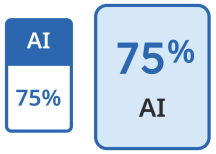
|
Blue with a percentage between 0 and 100: The submission has processed successfully. The displayed percentage indicates the amount of qualifying text within the submission that Turnitin’s AI writing detection model determines was generated by AI. As noted previously, this percentage is not necessarily the percentage of the entire submission. If text within the submission was not considered long-form prose text, it will not be included. Our testing has found that there is a higher incidence of false positives when the percentage is between 1 and 20. In order to reduce the likelihood of misinterpretation, the AI indicator will display an asterisk (*) for percentages between 1 and 20 to call attention to the fact that the score is less reliable. To explore the results of the AI writing detection capabilities, select the indicator to open the AI writing report. The AI writing report opens in a new tab of the window used to launch the Similarity Report. If you have a pop-up blocker installed, ensure it allows Turnitin pop-ups.
|
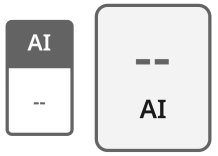
|
Gray with no percentage displayed (- -): The AI writing detection indicator is unable to process this submission. This state means that the AI writing report cannot be opened. This can be due to one, or several, of the following reasons:
|
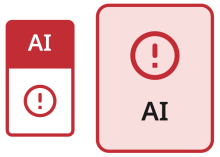
|
Error ( ! ): This error means that Turnitin has failed to process the submission. This state means that the AI writing report cannot be opened. Turnitin is constantly working to improve its service, but unfortunately, events like this can occur. Please try again later. If the file meets all the file requirements stated above, and this error state still shows, please get in touch through our support center so we can investigate for you. |
The AI writing report contains the overall percentage of prose sentences contained in a long-form writing format within the submitted document that Turnitin’s AI writing detection model determines was generated by AI. These sentences are highlighted in blue on the submission text in the AI writing report.
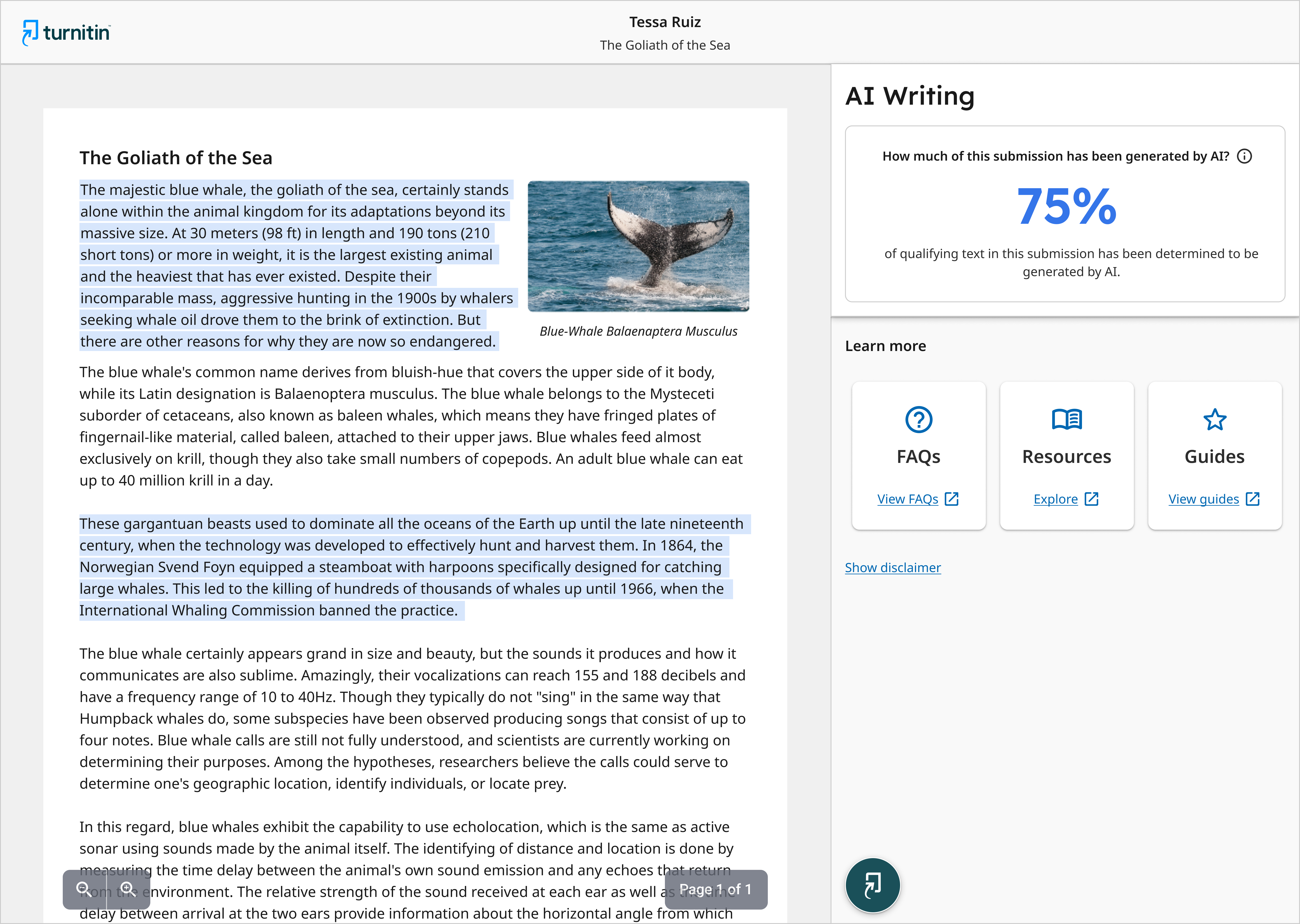
Prose text contained in long-form writing means individual sentences contained in paragraphs that make up a longer piece of written work, such as an essay, a dissertation, or an article, etc. The model does not reliably detect AI-generated text in the form of non-prose, such as poetry, scripts, or code, nor does it detect short-form/unconventional writing such as bullet points, tables, or annotated bibliographies.
This means that a document containing several different writing types would result in a disparity between the percentage and the highlights.
The percentage, generated by Turnitin’s AI writing detection model, is different and independent from the similarity score, and the AI writing highlights are not visible in the Similarity Report.
How Turnitin has made this determination is complex. To help our users understand Turnitin’s method of detecting AI writing text, we have created an extensive FAQ. Learn more about how Turnitin detects AI-generated writing.
Our AI writing assessment is designed to help educators identify text that might be prepared by a generative AI tool. Our AI writing assessment may not always be accurate (it may misidentify both human and AI-generated text) so it should not be used as the sole basis for adverse actions against a student. It takes further scrutiny and human judgment in conjunction with an organization's application of its specific academic policies to determine whether any academic misconduct has occurred.
2022 January 28th
Access restored to users within the People's Republic of China
A pathing issue between Turnitin's servers and users within the People's Republic of China had prevented these users from using our integrations. This has now been resolved and access has been restored.
This change resolves the known issue.
2021 September 23rd
Unnecessary pronouns removed from the paper view request email
Turnitin is committed to providing an equitable and inclusionary experience for everyone who uses our products. While this may be a relatively minor change, we are actively looking for areas we can improve in all aspects of Turnitin.
In this change, we found that the Paper View Request email unnecessarily gendered the instructor and did not account for users who do not identify as a binary gender.
Before this change:
This instructor has found a '23%' match to this paper in a paper submitted to his or her 'Natural History' class.
After this change:
The requesting instructor has found a '23%' match to this paper in their 'Natural History' class
2021 September 16th
0% similarity when using Translated Matching will callback to Canvas
If a Translated Matching Similarity Report came back as 0%, the score would not be passed back to Canvas. We've fixed this bug and the grade callback will be fired in this situation now.
2021 July 27th
Enhanced synonym swapping detection
One way people try to get around similarity matching is by changing words within plagiarized content to similar synonyms in the hope that we can’t detect these changes. With this release, we will catch more instances of this method of academic misconduct while not increasing false positives.
This enhancement will help to improve the accuracy of the Similarity Report and provide actionable insights instructors can use to promote original writing with their students.
As this is a refinement to how we generate the Similarity Report, you don't have to do anything to enable it. Any Similarity Reports generated from now on will simply be even more accurate than they were before if someone tries to cheat in this way.
2021 March 18th
Thanks for the Feedback!
Thanks for the feedback! We are so pleased that users are keen to work with us to make Turnitin a tool that truly reflects your needs. The user interview sign-up form will be going away for a little while as we start our first phase of testing. Worry not! It will be back later when we should have some exciting things to show you.
You can opt-out our user research at any time by following the 'Unsubscribe' link found in any email we send you.
2021 March 4th
This change doesn't require a plugin update
Turnitin’s similarity scores become more accurate and informative today
Similarity is at the heart of Turnitin and we always look for methods to make our reports more accurate and representative of the wide variety of sources students now have access to. Recently, we’ve refined how our similarity scores are calculated, and we’re excited to share it with our you.
While any changes to individual reports are relatively minor, it continues our commitment to providing Instructors with a reliable and genuine representation of a submission’s similarity.
This release includes:
- Better detection and exclusion accuracy of quotes
- Better prioritization of internet sources (for example prioritizing a match against wikipedia.com instead of randomblog.com)
- Better matching more content across our various databases
As always, all submissions to Turnitin are checked against our latest and most accurate similarity technologies. You may notice a small percentage of previously submitted papers experience minor changes as we continue to innovate.
Any questions? Check out our FAQ.
2021 February 17th
User Feedback Button has been added to Feedback Studio
Let’s talk! We want your help to shape the future of Turnitin. A User Feedback Button has been added to the Similarity Report viewer, allowing you to volunteer yourself to possibly become involved with surveys, one-on-one interviews, or previews of potential new products and features. This button is only visible for instructors.
If you would like to get involved, simply select the gray icon of the waving person on the panel within a Similarity Report. Complete the Sign-Up form to be entered into our database of potential participants. If you change your mind at any time, simply unsubscribe to any participation emails you receive.
We look forward to working with you!
2021 January 15th
Digital Receipts reflect the latest draft
When a file is submitted to Turnitin, we record the date and time it reaches us. A bug had caused us to only show the time of the first upload, even when we have received multiple drafts. Now, the date of the digital receipt will reflect the latest draft.
2020 October 13th
Faster saving voice comments
Audio comments will now save to Turnitin significantly more quickly. If you've experienced a delay in comments saving in the past, you'll now notice that the process will only take a matter of a few seconds.
2020 September 23rd
Voice comments now use HTML5
At the end of 2020, Adobe will deprecate their Flash technology in favor of other open standards. As a part of this, all major browsers have also announced their removal of support.
To help ensure an effortless transition between the two technologies, we have made the change earlier than the deadline. As of this release, we now use HTML5 to record voice comments for users. You should notice little to no difference in how you use Turnitin (except things might be just a little faster!).
2020 September 17th
A new 'Paraphrasing' QuickMark set
When referenced correctly, paraphrasing can be perfectly acceptable in a well-written essay. This new QuickMark set will give students an extra helping hand by giving you a simple and clear way of indicating parts of an assignment than might need a little extra attention. You'll find this QuickMark set already available to you in your QuickMark library.
2020 August 4th
All Users. All Integrations.
Check for common integrity Flags in a submission
Flags are a simple way of checking a document for common forms of academic misconduct. A Flag is not necessarily an indicator of a problem. However, if you find one in a submission, we'd recommend focusing your attention there for further review.
There are two forms of Flags available at launch - Replaced Characters and Hidden text. Both are methods touted on social media as ways of circumventing similarity matching.
Replaced Characters will highlight any time an author has used a character that is different from the rest of the document — for example, Swapping a Latin O with a Greek omicron Ο. To the naked eye, these are difficult to spot; now we’ll Flag them for you!
Hidden Text is an attempt to blend text in with a white background. This can lead to an artificially inflated word count or attempts to turn plagiarized text into quoted text, so it is excluded from the Similarity Report.
Certain Turnitin licenses. All Integrations.
View authorship data for a submitted file
Document details are just that - details about a document! All files have metadata that is attached by the computer they use and the software they use. Metadata is simply data about data; in this case, data about the file a user submits.
Depending on file type, this can include fonts used within the paper, the paper size, the author’s name, software used to compose the document, and a bunch of other useful information!
These details can be used to investigate multiple avenues of academic misconduct. For example, multiple fonts used in a document may indicate that content has been copied from the internet. A different author’s name may suggest that a student has used an essay writing service. There can be genuine reasons for these matches, but we’d recommend further investigation when something doesn’t look right
2020 July 1st
Students can now view their submission and instructor feedback without receiving error messages
It was discovered that a small number of students were receiving error messages when attempting to open their submission or view QuickMarks left by their instructor. This has now been resolved and students can view their papers and feedback without issue.
Grading Form bugs have been resolved
Our engineering team have been working on a few intermittent bugs that have been interfering with applying grades to Grading Forms. You may have experienced one of the following:
-
Grades may not have updated if they were applied or edited by navigating quickly through submissions using the arrows within Feedback Studio.
-
A grade may not have saved if applied before Feedback Studio had loaded fully after opening.
-
Selecting Apply to Grade may not have saved the criterion or rubric score.
These have all been resolved.
2020 June 17th
More accurate bibliography exclusions
For English language papers, Turnitin no longer requires the use of beginning and terminating phrases to identify a Bibliography. We now use a machine learning algorithm to understand the paper on a deeper level and dynamically exclude content with much greater accuracy. You should notice far fewer 'false positives' in your Similarity Reports when excluding the bibliography.
Read more on our bibliography exclusion page.
2020 June 10th
Code no longer automatically replaces certain text within Feedback Studio comments
If an instructor were to include an ampersand (&) or the word "prompt" within their inline comment on a student's paper, it would appear as & and < respectively. This has now been resolved and these phrases and symbols can be used as normal.
2020 April 22nd
This change does not require a plugin update.
A new notification before your session expires
Striking a balance between user convenience and account security is important to us. When we expire a session, we only do it to ensure that the person who returns to continue the session is still the person who started it.
We start the clock once we stop receiving any active input from the user. After three hours have elapsed without input, we will show a notification. This notification says that in 10 minutes your session will expire, but that you can use the Extend Session button to keep grading. Once the 10 minutes have passed, you'll have to log in again.
If you are writing a particularly long comment, and know you are about to take a break, navigate outside of the comment box to ensure that it saves.
When we expire a session, all unsaved work is lost. Saving happens automatically when we detect input from the user. However, in some cases, it's possible that the sync didn't happen because the rest of the page wasn't interacted with.

2020 February 26th
Turnitin Feedback Studio Viewer session extension
After listening to customer feedback, we’ve extended the session time for our viewer from one hour to three. This change means instructors will have longer to grade and leave feedback without worrying about being timed out.
2020 February 13th
Rubric manager issues have been resolved
Some users had experienced varying problems with our rubric manger such as not being able to select a rubric, create a new one, and formatting issues. The bug that caused this issue has been fixed and users should be able to use rubrics again as a part of their assignment.
2020 February 6th
We are now fully compliant for the release of Chrome 80
With the release of Chrome 80 fast approaching, we have ensured that users will be able to use our products in Chrome without further disruption. We have made the required changes to our cookies for all of our LMS integrations and Single Sign-On integration Shibboleth to ensure that users will no longer encounter warnings about 3rd party cookies if they are enabled.
2020 February 5th
This change does not require a plugin update.
Star rubrics and grading forms for easy access
Time for a little (early) Spring cleaning! This new feature allows you to star up to five rubrics and grading forms. Starring a rubric or grading form will move it to the top of the Rubric and Form manager for easy access. Starred rubrics and grading forms will stand out amongst all the others in this and future assignments.
Learn how to star a rubric or grading form, remove a rubric or grading form, or how to view the ones you have starred already
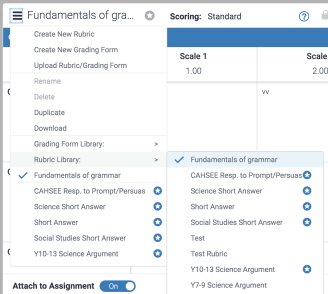
2020 January 15th
This change does not require a plugin update.
A new sub-menu for rubrics and grading forms
By default, we provide many rubrics and grading forms to help you get started with your Turnitin account from the very first time you access it. However, as we have a global community of instructors and institutions, it is only natural that not every rubric is relevant to every instructor. To help with the organization of rubrics and grading forms, we’ve moved them to their own sub-menus within the Rubric and Grading Form Manager. This sub-menu is more visible on the screen, making it easier to scroll through and find the one you would like to attach to an assignment. The currently attached rubric or grading form is always visible from the top-level of the menu.
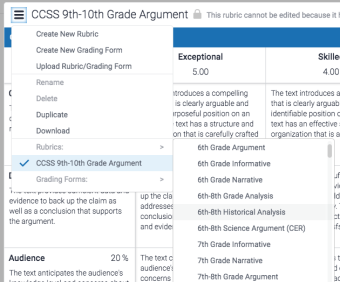
2019 October 23rd
Match overview percentage now appears for translated matches in English
A bug had prevented the overall percentage wouldn’t show after clicking the ‘View English Sources (beta)’ button. We're happy to report that this bug has been squished and the match overview percentage will now display as expected.
2019 September 18th
Anonymity is maintained when duplicating assignments
A bug had potentially caused anonymity to be lost when opening Turnitin Feedback Studio when an assignment was duplicated and a student submitted before an instructor had accessed the settings page. This has now been resolved and anonymity will be maintained at all times.
2019 September 13th
Continued accessibility improvements
Focus order for interactive elements is more logical
When a screen reader looks at a page, it goes through the elements on the page in a set order. We have changed the tab order within our text-only viewer to add a more logical progression through the page.
New ‘Skip to Content’ link as the first navigable element in the text-only viewer
When using the ‘Show highest matches together’ or ‘show matches one at a time’ modes of the text-only viewer, you’ll now find a ‘skip to content’ link as the first element that is reachable when using the tab key. Following this link will jump you to the first part of the similarity report.
2019 September 3rd
Fixed a bug causing Turnitin Feedback Studio Viewer to freeze
A pesky bug was found that would cause the Turnitin Feedback Studio Viewer to freeze when creating a comment. We squashed this bug as part of our ongoing commitment to improving the Turnitin Feedback Studio Viewer.
2019 August 21st
The undo prompt will now disappear as intended
When you delete a QuickMark, we show an undo prompt at the top of the screen to help you recover from any accidental misclicks. This undo prompt will vanish a couple of seconds after your next interaction with the viewer. A bug had made this prompt stay on the screen permanently. Now, deleting a QuickMark should only show the undo prompt for the intended amount of time.
2019 June 18th
Turnitin messages now appear within Speedgrader
If a student’s submission fails to generate a similarity report, a descriptive message will appear to instructors in Speedgrader explaining why. For example, if a submission does not meet the minimum word count required to generate a report, a message will appear explaining “Your submission must contain 20 words or more”.
2019 April 4th
Text-based submissions can now be greater than 10,000 characters in length
We’ve resolved a known issue with our text submission for Canvas Plagiarism Framework and LTI. When using our 'text' or, as you may also know it, 'copy and paste' upload, a limit on this field had restricted the number of characters you could send to Turnitin to 10,000 characters. This issue has been resolved.
2019 March 21st
You can now use resubmit to Turnitin when using SpeedGrader for group submissions
While it was possible to resubmit to Turnitin when using SpeedGrader for single submissions, it was not possible to use it for group submissions due to the underlying logic of how we process files for multiple students. However, we have reworked how group submissions are handled once they reach Turnitin and applied a change that now makes it possible to resubmit to a group submission!
2019 March 12th
Updated similarity scores will pass back to Canvas on the assignment due date
On the due date for an assignment, Turnitin automatically reruns the similarity score to help check for collusion or find any updated matches. A confluence of problems had prevented Turnitin from successfully sending this updated similarity score back to Canvas.
With this release, we have fixed these underlying issues and scores will now successfully update in Canvas on the due date.
2018 December 5th
Anonymous marking now supported!
Anonymous marking is now supported with both the Canvas Plagiarism Framework and Canvas LTI integrations!
This means that the feature only needs to be selected from within the Canvas assignment settings, which will then automatically apply to the Turnitin assignment settings.
Check out our guidance for help getting anonymous marking set up.
Anonymous marking differs in our Canvas integrations. Anonymous marking in Turnitin is a permanent setting. If you disable anonymous marking on an assignment following a student submission, you will be unable to reactivate it. This differs from the Canvas workflow. In the Canvas Plagiarism Framework and Canvas LTI integration you will be able to reactivate the anonymous feature even after a student has submitted. If you reactivate anonymous grading in Canvas after a submission has been made, the identify of the student will remain visible within the Turnitin viewer.
2018 November 21st
SpeedGrader resubmission bug
We’ve fixed a bug that was causing already graded submissions not to process when the “Resubmit to Turnitin” button was used. The “Resubmit to Turnitin” button now works in SpeedGrader after a submission has been graded.
User details from Canvas now stored in Turnitin
We are now retrieving basic user details which should help improve the quality and timeframe of support we can provide.
2018 October 17th
We’ve improved how we manage key dates when copying an assignment
When copying a Canvas Plagiarism Framework assignment, all settings are copied from the original assignment, including key assignment dates. However, when a copied course contained a start date more than a year in the past, this caused Turnitin assignment creation to fail. Not to worry… we’ve fixed this by automatically updating dates that are too far in the past to guarantee smooth assignment copying from here on out.
Students can successfully view their Similarity Reports
We found that students were unable to view their Similarity Report in some copied courses as a result of the “Allow students to see Similarity Reports” setting being set to “no” in Turnitin.com or TurnitinUK.com. We’ve fixed this issue so that students always have the correct access to their Similarity Reports, regardless of any external settings.
2018 October 4th
We've fixed the duplicate student problem plaguing some users
We have fixed an intermittent issue where some students submitting to Turnitin via the Canvas Plagiarism Framework have had a duplicate user created in Turnitin. This resulted in students sometimes receiving 100% matches to their own paper, due to Turnitin considering a single student as multiple users with the same paper. Duplicate users should no longer be created, and if your institution has potentially experienced this with any assignment, please contact the Turnitin product support team and we will work to resolve this for your account.
2018 September 4th
A minimum of one repository must be selected to generate Similarity Reports
We realized that it should be possible to only deselect a maximum of two repository options in your assignment settings, whilst leaving one repository as a minimum requirement. With no repositories to search against, it was impossible to generate a report. Oops!
Available repository options include: Student, website, and periodicals, journals, and publications.
2018 August 30th
Administrators can now set up the Plagiarism Framework with Turnitin sub-accounts
Previously, only the Turnitin accounts that you administered could be linked to Canvas for use with the Plagiarism Framework. Now, you can link any of your main account's sub-accounts to Canvas, even if a sub-administrator is assigned to it.
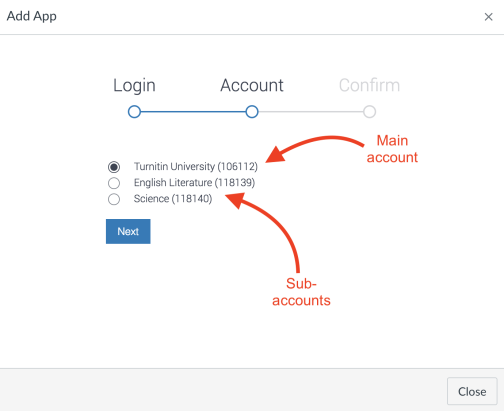
2018 August 24th
We've made Turnitin assignment settings easier to follow
We received some feedback from users that the "Store submissions in" drop-down menu appeared broken and unusable. The reality was that their administrator had opted for all submitted papers to be stored in the standard repository. This automatically disabled the drop-down menu.
Now, when a Turnitin administrator chooses this option, we'll remove the "Store submissions in" drop-down menu completely:

2018 June 27th
Introducing ETS e-rater® to the Canvas Plagiarism Framework!
Pressed for time? We can help with that! Grab a snack, sit back, and relax as you watch Turnitin's grammar feedback technology automatically check your students' submissions for grammar, usage, mechanics, style, and spelling errors. ETS e-rater® provides rich, in-depth feedback with customizable on-paper marks to make the grading process even easier.
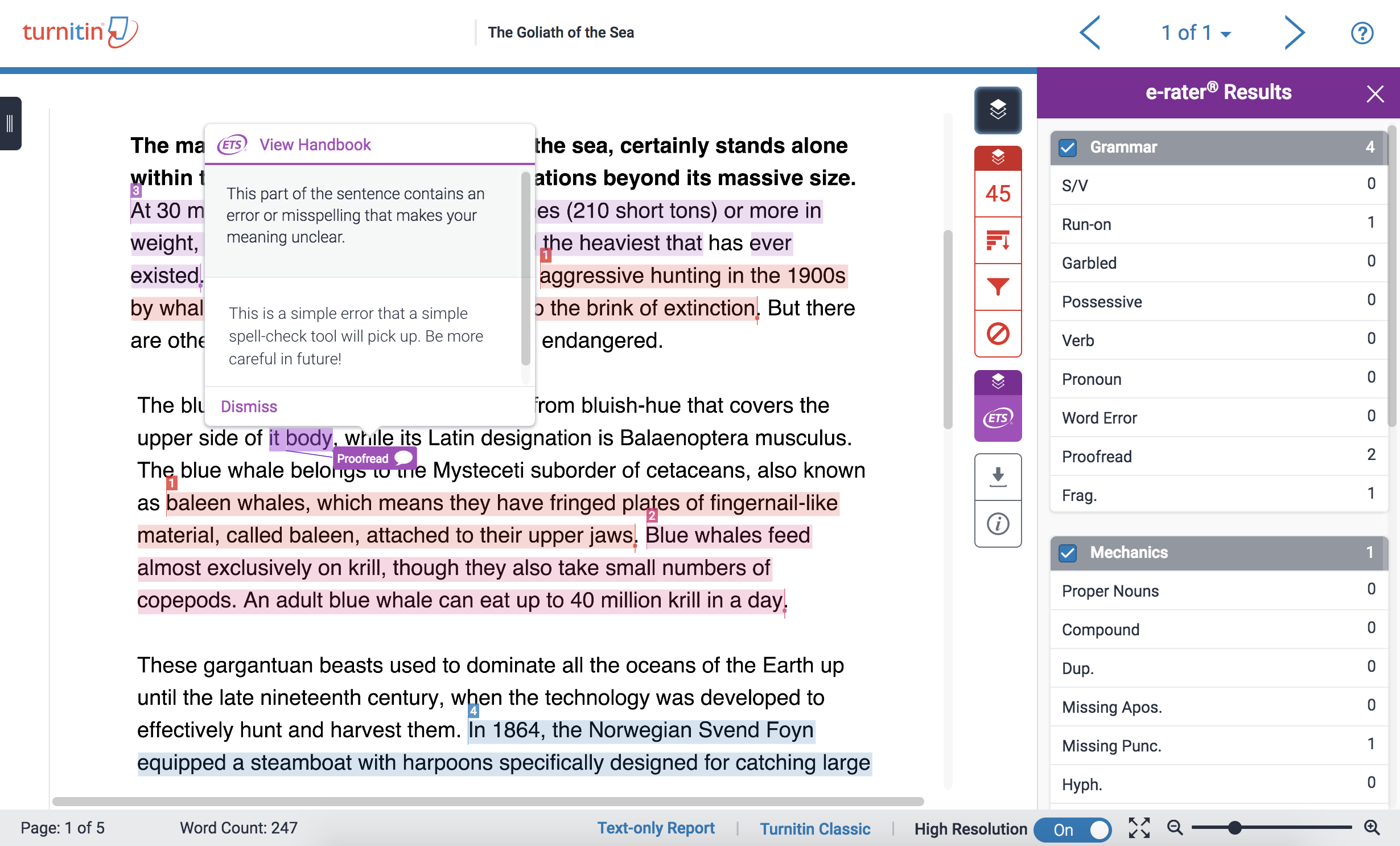
To start using ETS e-rater®, administrators must enable this on their account. Once enabled, instructors can configure e-rater® grammar check technology right from their Canvas Plagiarism Framework assignment settings!
2018 April 5th
No more duplicate papers after grading in Canvas SpeedGrader
We've been working with Canvas to resolve an issue with papers duplicating in Turnitin.com and TurnitinUK.com; this followed grading within Canvas SpeedGrader. The good news is that we've fixed it! There is no bad news!
Turnitin now rejects any unsupported file or submission types
We received reports that some papers submitted to the Canvas Plagiarism Framework were stuck in a pending state; we found that this was mostly down to unsupported file types being submitted. To prevent users from seeing this pending state in future, Turnitin will immediately reject any unsupported file or submission type.
Turnitin supports the following Canvas submission types:
- Text entry
- File upload (this includes cloud submission e.g. Google Drive). Accepted file types for generating a Similarity Report can be found here.
Website URL
Media recordings
Turnitin does not support the following Canvas submission types:
If a submitted paper fails to generate a Similarity Report and no pending message is displayed, students should review our file requirements and resubmit with an accepted file type.
Assignments are now created with start dates before due date
When using the course copy or import course content methods in Canvas, we’re often supplied with the due date for an assignment, but not a start date.
Due to Turnitin’s date logic/requirements, assignments failed to create when the due date was set to a past date and no start date was provided; this is because Turnitin sets the start date to today, and in Turnitin, the assignment can't be created unless the start date is before the due date.
To resolve this, we now always ensure that the assignment start date is set prior to the due date supplied to us. It's worth noting that Turnitin does not require a start and end date to produce a Similarity Report within the Canvas Plagiarism Framework. Start and end dates are controlled by Canvas.
Our guidance will soon cover the supported course copy/content import methods supported by Turnitin.
2018 March 20th
Set up group assignments using the Plagiarism Framework!
The start date of a Canvas Plagiarism Framework assignment failed to match the start date of the same assignment inside Turnitin, with the Turnitin start date appearing to be a full day earlier than the creation date in Canvas. We've pushed a fix to ensure that Turnitin accurately displays an assignment's start date and time.
An alert is displayed when using an unsupported environment for testing
The next time you attempt to register Turnitin in a test or beta Canvas environment, you'll be alerted that Instructure/Canvas does not support this. While we encourage testing in supported environments only, you can continue testing in the current environment at your own risk. If you have any questions about testing support, please contact your Canvas representative.
For reference, Canvas does not reliably support the Canvas Plagiarism Framework in the following environments:
*.test.instructure.com
*.beta.instructure.com
For guaranteed quality assurance, all testing should be carried out in the production environment only:
*.instructure.com
A multi-file submission will now process successfully
If a student submitted multiple files for a single submission, we found that the first paper managed to process just fine, but the rest sat pending or in an error state. We made a few tweaks, and now, all acceptable files will indeed process, rather than just one. Phew!
2018 February 26th
We've introduced full support for copying a course
News just in! Any assignments created as part of the Canvas Import course content feature will automatically copy Plagiarism Framework settings from the original assignment. This makes for a snappy turnaround when creating new assignments! Not quite sure how to do this? Take a look at Canvas guidance for importing course content.
You can now exclude small sources from the Similarity Report
It's all happening in Canvas! We've just added a setting to the Plagiarism Framework to allow for the exclusion of small sources from the Similarity Report.
During assignment setup, you now have the option to set a small source exclusion value; this value can be a number of words or a percentage. To exclude small sources, Turnitin looks at the size of a matching source and makes any necessary exclusions based on the threshold specified.
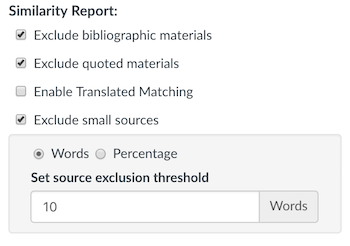
Your storage repository options now populate correctly
We noticed an issue with the options available in the Store submissions in drop-down list within the Canvas Plagiarism Framework settings. After making some backend adjustments, the drop-down list now populates with the correct options, depending on the administrator's configuration (remember that the available repository options vary based on this configuration!).